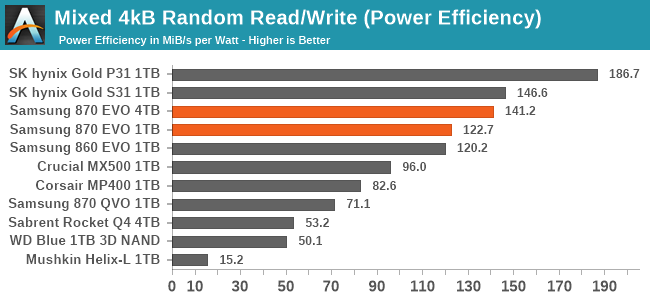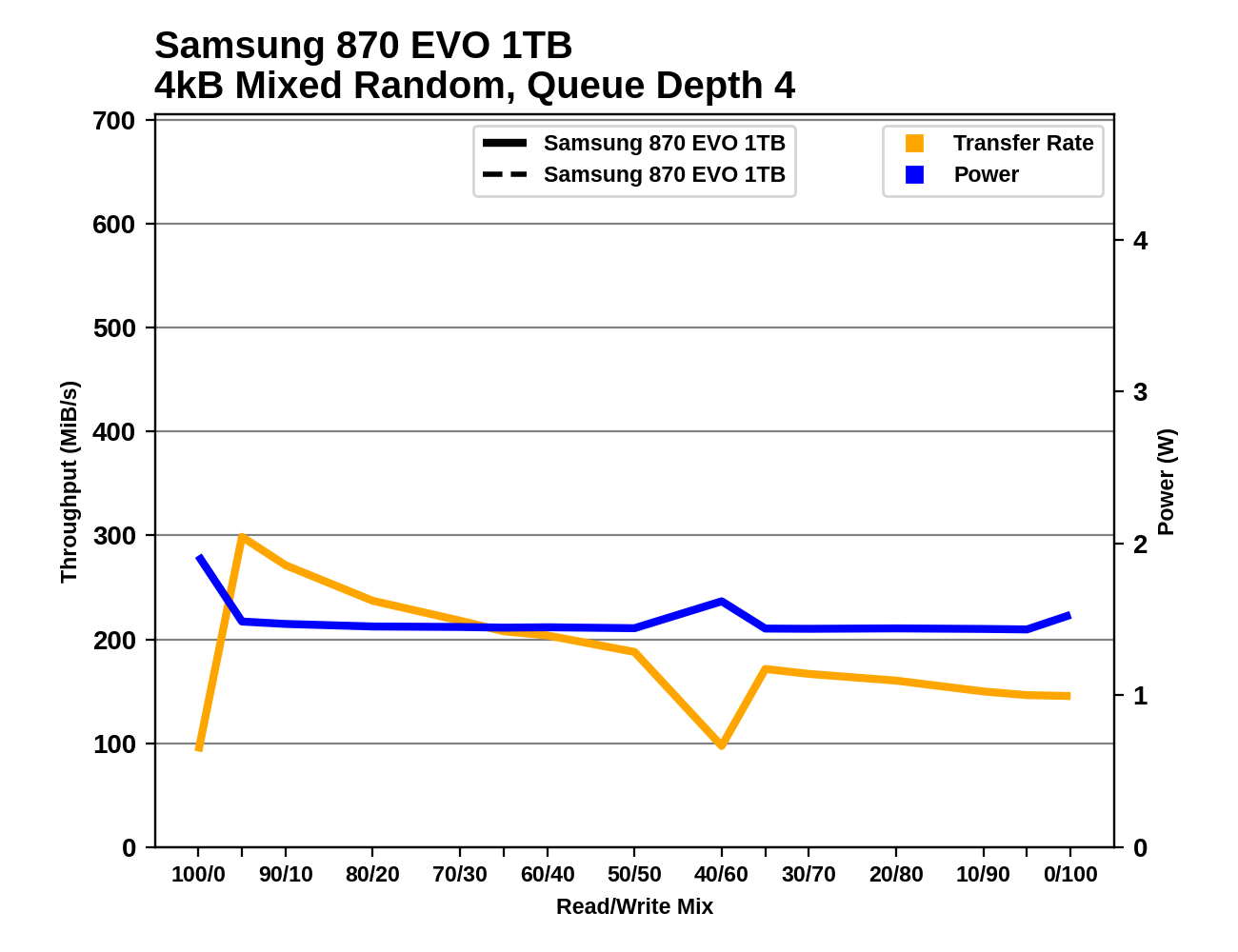The Samsung 870 EVO (1TB & 4TB) Review: Does the World Need Premium SATA SSDs?
by Billy Tallis on February 17, 2021 8:00 AM ESTMixed IO Performance
For details on our mixed IO tests, please see the overview of our 2021 Consumer SSD Benchmark Suite.
 |
|||||||||
| Mixed Random IO | Mixed Sequential IO | ||||||||
The mixed random IO test provides the Samsung 870 EVO with one of its biggest performance wins yet over the rest of the SATA field and the entry-level NVMe competition. But most of that comes from the capacity advantage the 4TB model has over most of these comparison drives; the 1TB 870 EVO is only about 5% faster overall than the 860 EVO. On the mixed sequential IO test, the SATA bottleneck keeps most of the performance scores within a fairly narrow range, and the 1TB 870 EVO's performance is actually a bit of a regression compared to its predecessor.
 |
|||||||||
| Mixed Random IO | Mixed Sequential IO | ||||||||
As with our separate tests of random reads and writes, the top efficiency scores for mixed random IO go to SK hynix, with Samsung's TLC drives turning in the next best scores and having a clear advantage over other competing brands. Over on the sequential IO side of things, the efficiency scores more closely mirror the performance scores, and the 870 EVO doesn't have any real advantage over other mainstream SATA drives.
 |
|||||||||
| Mixed Random IO | |||||||||
| Mixed Sequential IO | |||||||||
The 1TB 870 EVO's performance during the mixed random IO test is more consistent than the 860 EVO's, but still has a few unpleasant drops that aren't present for the 4TB model. On the mixed sequential IO test, the 1TB 870 EVO's performance is actually a bit less consistent than the 860 EVO. But aside from those occasional outliers, the general trend is for the 870 EVO to provide superior random IO performance and link-saturating sequential performance across a wide range of workload mixes.
Idle Power Management
Real-world client storage workloads leave SSDs idle most of the time, so the active power measurements presented earlier in this review only account for a small part of what determines a drive's suitability for battery-powered use. Especially under light use, the power efficiency of a SSD is determined mostly be how well it can save power when idle.
SATA SSDs are tested with SATA link power management disabled to measure their active idle power draw, and with it enabled for the deeper idle power consumption score and the idle wake-up latency test. Our testbed, like any ordinary desktop system, cannot trigger the deepest DevSleep idle state. For more details, please see the overview of our 2021 Consumer SSD Benchmark Suite.


The Samsung 870 EVO may feature an updated controller compared to the 860 EVO, but there's no real difference in idle power consumption, for either active idle or the desktop (non-DevSleep) idle states. Samsung's idle power figures are best in class, with SK hynix offering the only close competition.

The Samsung SATA drives all take about one millisecond to wake up from using SATA link power management. This is higher than several of the other SATA drives, but not really enough to be of much concern for system responsiveness.










136 Comments
View All Comments
Kamen Rider Blade - Thursday, February 18, 2021 - link
That's why I buy & use SATA BackPlanes =DCooperdale - Saturday, February 20, 2021 - link
My motherboard has SATA Express support. Not a SATA upgrade as much as a kind-of-hybrid between SATA and NVMe. But yes I see what you mean. It failed miserably though.Juraj_SK - Wednesday, February 17, 2021 - link
I think SATA is dead. Even with a newer version it's still a terrible interface for drives. Not only it doesn't provide power (so you need a separate cable from the PSU), but the drive itself needs a box and the whole thing takes a lot of space (often wasted inside - you could literally cut some SSD in half and it would still work :D).Whereas NVMe is chip only, super small, power included. No wasted cables or materials and it's connected with PCIe just like everything else.
eek2121 - Wednesday, February 17, 2021 - link
NVME is limited by surface area, so I wouldn’t count SATA as being dead yet. A SATA drive will always be able to hold more data than an NVME drive.DanNeely - Wednesday, February 17, 2021 - link
Except at the silly fringe that doesn't matter though. A sata drive packing more flash than can fit into an m.2 is going to be crazy expensive for a consumer model; and in the enterprise market taking several times longer than an m.2 drive to fill (think initial fill or raid rebuilds) is a major liability.eek2121 - Wednesday, February 17, 2021 - link
It isn’t a silly fringe thing. There are legitimate needs for bulk storage. One of my clients has a database that is 44TB in size.Guspaz - Wednesday, February 17, 2021 - link
Except for enterprise use there are already pcie-based connection standards for 2.5” drives. SATA isn’t needed for that.schujj07 - Wednesday, February 17, 2021 - link
If you have a 44TB DB that would be placed on a physical SAN typically. The only other possibility is the entire DB is a physical appliance. Either way the server will have multiple 2.5" drive bays. Depending on the age of the server, those slots will either be SATA/SAS, SATA/SAS/NVMe, or strictly NVMe. Either way both SAS and NVMe have drives larger than 15TB. Outside of one company (and that is a 3.5" SSD), the largest Enterprise grade SATA SSD are 7.68TB now. Sure you can purchase older ones on SATA that are larger, but with the rapid adoption of NVMe there isn't any reason to go SATA unless absolutely required. Also when it comes to cost, SATA Enterprise SSD isn't much cheaper than Enterprise NVMe, SAS is still overpriced though.CaedenV - Wednesday, February 17, 2021 - link
"It isn't a silly fringe thing" and then proceeds to put forward an extremely fringe case.Just how many people have a 44TB DB laying around their house? This is consumer equipment. Don't put a 44TB DB on consumer equipment!
stancilmor - Thursday, February 18, 2021 - link
44TB? That is small potatoes. I’m dealing with storage requirements in double digits of PB annually. Certainly not consumer level when just drives cost in the millions.For home use I rely on the hot plug feature of SATA. For the hot plug feature I’ll be switching to USB C, USB 4 or thunderbolt 3 or 4. I still don’t have an M.2 Drive, but likely the next system upgrade will include an M.2 for the OS. SATA is getting to be too slow.
As for the Samsung drives. I recently upgraded an aging laptop’s mechanical drive with the EVO 870 simply, because the 860 had too long of a shipping time.
I also almost exclusively use Samsung drives in upgrades, because of how well the Samsung data migration tool works. I have tried Acronis and use clonezilla, both have created unusable clones on occasion. Samsung’s Data Migration just works, even on a running system.